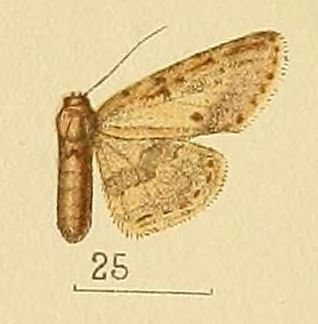
Kenrickodes is a genus of moths of the family Noctuidae described by Viette in 1961. The species are known from Madagascar.
Eutelephia is a monotypic moth genus of the family Erebidae erected by George Hampson in 1926. Its only species, Eutelephia aureopicta, was first described by George Hamilton Kenrick in 1917. It is found on Madagascar.
Leucotelia is a monotypic moth genus of the family Erebidae erected by George Hampson in 1926. Its only species, Leucotelia ochreoplagata, was first described by George Hamilton Kenrick in 1917. It is found on Madagascar.
Phoberopsis is a monotypic moth genus in the family Lasiocampidae first described by Yves de Lajonquière in 1972. Its only species, Phoberopsis ferox, described by George Hamilton Kenrick in 1914, is native to Madagascar.
Lophocera is a genus of snout moths described by George Hamilton Kenrick in 1917.
Lophocera flavipuncta is a species of snout moth in the genus Lophocera. It was described by George Hamilton Kenrick in 1917 and is known from Madagascar.
Borocera attenuata is a species of Lasiocampidae moth native to Madagascar. It was first described by George Hamilton Kenrick in 1914.
Anania elutalis is a species of moth of the family Crambidae. It was first described by George Hamilton Kenrick in 1917 and is found on Madagascar.
Syllepte hemichionalis is a moth species in the genus Leucinodes of the family of Crambidae. It is found in Madagascar and on the Comoros.
Comostolopsis subsimplex is a moth of the family Geometridae first described by Louis Beethoven Prout in 1913. This species was described from Madagascar.
Glyphodes paramicalis is a moth of the family Crambidae described by George Hamilton Kenrick in 1917. It is found in Madagascar.
Xanthodesma rectangulata is a moth in the family Noctuidae. It was first described by George Hamilton Kenrick in 1917 and is known from Madagascar.
Calligraphidia tessellata is a moth in the family Noctuidae. It was first described by George Hamilton Kenrick in 1917 and is known from Madagascar.
Acontia gloriosa is a moth of the family Noctuidae. It was first described by George Hamilton Kenrick in 1917 and is found in Madagascar.
Corgatha subindicata is a species of moth of the family Erebidae. It was described by George Hamilton Kenrick in 1917 and is found in Madagascar.
Syllepte desmialis is a moth in the family Crambidae. It was described by George Hampson in 1912. It is found in Nigeria.
Syllepte microstictalis is a moth in the family Crambidae. It was described by George Hampson in 1918. It is found in Cameroon.
Syllepte subcyaneoalba is a moth in the family Crambidae. It was described by George Hampson in 1918. It is found in Cameroon.
Syllepte nasonalis is a moth in the family Crambidae. It was described by George Hampson in 1898. It is endemic to South Africa.
Syllepte purpurascens is a moth in the family Crambidae. It was described by George Hampson in 1899. It is found in the Democratic Republic of the Congo, Kenya, South Africa and Tanzania.